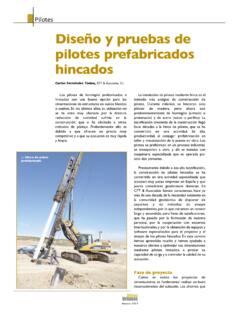Transcription of DYNAMIC TESTING OF MICROPILES. …
1 1 DYNAMIC TESTING OF micropiles . comparison OF static AND DYNAMIC TEST RESULTS D. Carlos Oteo1, D. Jos Luis Arcos2, D. Rafael Gil3, D. Carlos Fdez. Tadeo4 ABSTRACT micropiles are used for many applications, including underpinning existing foundations. Improving of technique is required to support large loads and quick control methods are demanded. Under this project, a micropile test site was established at Algete in Madrid, Spain. Three micropiles were installed with 3, 5 and 7 meters each in length, borehole diameter of 150 mm and a steel casing external diameter/thickness of mm. DYNAMIC load TESTING was performed in the test area. A little hammer was developed for TESTING with a variable mass between 500 Kg and 1000 Kg that can run along one meter. The Pile Driving Analyzer (PDA) technique was used to investigate the ultimate capacity of the micropiles .
2 A static load test was performed to estimate the bearing capacity of the micropiles . The results of the TESTING program demonstrate that PDA TESTING may provide accurate information using this technique. The paper, therefore, will discuss the techniques used for PDA TESTING of the micropiles , and compare the results of the PDA tests to the data from a static load test. 1. INTRODUCTION Micropiling works are very common in Spain and are used for many applications and in various soils. Heavily reinforced micropiles with high axial load-carrying capacities are often used, having borehole diameters of up to 300 mm with bearing capacities over 2500 kN with applications including building, tank and bridge foundations. The TESTING of individual micropiles is often mandated as part of a project specification in large construction works.
3 DYNAMIC micropile TESTING can be an integral part of a quality assurance system in the sense of confirmatory TESTING and a good complement or alternative to static vertical load TESTING . Kronsa Internacional together with A Coru a University initiated in October 2006 a research programme involving the construction and TESTING of three micropiles of 3, 5 and 7 metres in length. DYNAMIC load TESTING was carried out using a specially developed, hydraulic free fall hammer. PDI equipment was used and CAPWAP analyses were performed. A Class A , prediction without knowledge of the static test result was done. In December 2007, a new micropile with 7 meters length was installed close to the DYNAMIC TESTING area and a static load test was carried out. Simultaneously, a new DYNAMIC test was performed on previously tested micropiles . 1 Doctor Engineer, A Coru a University, A Coru a, Spain, Email: 2 Director, Grupo Rodio-Kronsa, Madrid, Spain, Email: 3 Design Engineer, Grupo Rodio-Kronsa, Madrid, Spain, Email: 4 Director, CFT & Asociados, , Barcelona, Spain, Email: 2 This paper presents the outline of the test micropile programme, summarises the results of the DYNAMIC load test and provides a comparison of these results with the static load test data.
4 2. SOIL CHARACTERIZATION OF THE TEST AREA The soil where the tests were carried out can be described as a gravel layer about 2 meters thick, overlying silty clay with a fine sand layer with a thickness greater than 20 meters. Water level was about 1 meter deep measured from ground surface at the moment of test execution. 3. MICROPILE TEST PROGRAMME High strain DYNAMIC load test Micropile installation Kronsa installed the micropiles by pre-drilling with a Head Hammer and using simultaneous injection of water throughout the process. A provisional casing was also used. The borehole diameter of the installed micropiles was 150 mm. Once pre-drilling was completed, the reinforcement, a cylindrical steel tube with external diameter of mm and 9 millimeter wall thickness was introduced inside of the predrilled hole.
5 For grouting, a tremie pipe was inserted to the bottom of the hole to initiate gravity filled grouting and continued until the grout reached the top of the casing. After grouting, the provisional casing was retracted and removed. Hammer system Introduction of an automatic hydraulic free fall hammer was carried out. This hammer can be mounted on a standard retroexcavator machine. This allows for rapid positioning at every micropile to be tested. The hammer allows for repetitive blows by the hydraulic power of the excavator. The ram mass is formed by a compact block of 500 kg plus additional mass that can be increased progressively to 1 ton. The maximum stroke is 1 meter (max. energy 1 m t), but this height is also adjustable. For a proper selection of the hammer to be used for DYNAMIC TESTING , Hussein et al. (1996) suggests a ram weight of about of the static resistance to be used.
6 In the test, static resistance mobilized was very high, necessitating a maximum drop hammer height, while assuming risks with regard to micropile integrity. PDA and CAPWAP method DYNAMIC measurements of strain and acceleration under hammer impacts are the basis for modern DYNAMIC pile TESTING . The equipment consists of two each of strain transducers and accelerometers, bolted to the steel casing of the micropile approximately one meter below its head, and a Pile Driving Analyzer, PAK model (PDI, 2004). Basically, it applies Case Method equations to pile force and velocity data in real 3 time between hammer blows after providing signal conditioning, amplification, filtering, and calibration to measured signals and data quality assessment. High strain DYNAMIC pile TESTING has been incorporated into many standards and specifications and is now a routine procedure in modern deep foundation practice worldwide.
7 The micropile has a composite section which must be considered in the analysis. The wave speed should be calculated form the average modulus and specific weight of the steel/concrete composite. On the other hand, the micropile is non-uniform, and we cannot properly use the Case Method and assume a uniform pile . In this case, we must analyze the data with the Case Pile Wave Analysis Program (CAPWAP). This signal matching analysis program is considered a standard procedure for the capacity evaluation from high strain DYNAMIC pile TESTING data. Using one pile top measurement, like the downward stress wave, CAPWAP iteratively alters the soil model to calculate and obtain a best match with the complimentary wave, such as the measured upward traveling wave. Previous studies of databases, and individual experiences, have demonstrated generally good correlation of CAPWAP signal matching results on DYNAMIC restrike tests with static load tests , mainly, on precast driven piles and drilled shaft piles.
8 However, there are relatively few experiences with micropiles . DYNAMIC test results In order to perform the DYNAMIC TESTING the micropiles needed to be prepared. The micropile reinforcement consisted of a cylindrical steel casing where were made eight drills. On the other hand, the head of each pile was fitted with reinforcing bars welded to the steel casin. Two piezoelectric accelerometers and two strain transducers were attached to the micropile head with the help of the drills. 4 Photo 1. Hammer system and micropile with instrumentation. Cushioning was provided between the head of the pile and the hammer, consisting of a cylindrical piece of oak wood, having a 10 cm thickness. In order to mobilize as much soil resistance as possible the, test employed increasing hammer energies. TESTING of each micropile was performed by striking the pile initially with a low energy blow.
9 The drop height was increased until the micropile was moved several centimeters. The set of the pile top (head) was recorded for all blows (Kormann et al. 2000) In addition to PDA TESTING , CAPWAP analyses were performed on all blows and micropiles in order to get additional data on pile response to loading and to confirm the capacity obtained from PDA TESTING . During TESTING , large displacements at the head of the micropile were noticeable during final blows. When the micropile shaft was broken (meaning by broken?), the capacity reduced quickly. In last blows, micropile was practically driven with set per blow close to 20 mm. The Ultimate Capacities for the 3, 5, and 7 m length micropiles are shown graphically in Fig. 2, 3 and 4. These values are based on CAPWAP analyses. 5 MK-3m. Ultimate Capaciy vs Blow Number0100200300400500600700123456 Blow n Ultimate Capacity [kN]020406080100120 Stroke [cm]Ultimate Capacity [kN]Stroke[cm] Figure 1.
10 Ultimate Capacity micropile 3 m length from CAPWAP and stroke per blow. MK-5m. Ultimate Capacity vs Blow Number010020030040050060070080090010001 2 3 4 5 6 7 8 9 10 11 12 13 14 15 16 17 Blow n Ultimate Capacity [kN] 020406080100120 Stroke [cm]Ultimate Capacity [kN]Stroke [cm] Figure 2. Ultimate Capacity: Micropile (5 m length) from CAPWAP and stroke per blow. MK-7m. Ultimate Capacity vs Blow number010020030040050060070080090010001 2 3 4 5 6 7 8 9 10 11 12 13 14 Blow n Ultimate Capacity [kN]020406080100120 Stroke [cm] Set per Blow [mm]Ultimate Capacity [kN]Stroke [cm]Set per Blow [mm] Figure 3. Ultimate Capacity: Micropile (7 m length) from CAPWAP and stroke per blow. 6 static vertical load test Micropile and anchor installation A new 7 meter length micropile was installed to be tested statically. This micropile was placed a few meters away from the three piles tested dynamically in the same soil conditions on December 4th, 2007.





